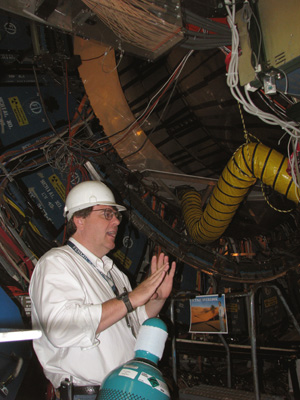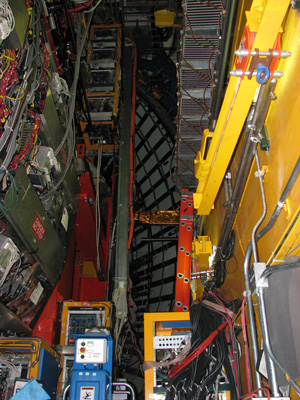CDF implements clever leak fix during shutdown
 |
| Mike Lindgren, PPD CDF department head, shows the plastic seal built around the western silicon detector to give workers access to water cooling tubes while keeping the detector cool and dry.
|
 |
| During shutdown, workers move inside the detector to make repairs and perform inspections.
|
To fix a multistory, multimillion-dollar detector, CDF employees had to think small. Really small.
Pencil-sized aluminum tubing bringing cooling water to the electronics covering the silicon detectors deep in the heart of the CDF
machinery sprang a leak. Without cooling water, the outer layers of electronics shut down, limiting data taking on the east side of the detector
for the final two months before the summer shutdown.
The crew had to find a way to plug the leak at a faulty weld without taking the entire silicon structure apart, which wasn't possible.
"There is just no way you can get to the outside of it," said Mike Lindgren, PPD CDF department head. "You can only work through these tubes."
With the help of Ken Schultz, operations specialist with PPD, Peter Wilson, the CDF operations co-head, and his staff found a solution.
Using medical tools that doctors normally snake through human arteries, Schultz fashioned a camera that threads through the coolant tubing to find the leaks. Schultz also designed a tool to cover the welds with epoxy from inside the tubing. All 16 of the aluminum welds were sealed as a preventative measure.
That fix was by far the most complicated of many CDF repairs made during the shutdown, Lindgren said.
Scientists and technicians at CDF had to design and build a special environment to allow the coolant system repairs while keeping the silicon
detectors healthy.
Silicon detectors that are allowed to warm up to room temperature lose some of their sensitivity, increasing background particle noise, making the tracks of the real particles more difficult to find.
To prevent that, the repair team built seals on each end of the experiment that would allow dehumidifiers to pump dry air into the CDF silicon detectors, so that workers could keep them cold without allowing ice to build up.
"Wilson and his team designed and built the system in record time so that it was ready for the start of the shutdown," Lindgren said.
The repairs took place on top of the normal shutdown duties, which serve as a tune-up of sorts for CDF.
Scientists check every part of the machinery, including light bulbs, electrical fans and water supplies that keep CDF functioning properly.
Scientists working on CDF keep a list of jobs, so that when the accelerator shuts down, they can complete repairs as quickly as possible.
During the shutdown, the detector opens up so that workers can squeeze inside and make repairs. Inside, fans whir and cold water rushes through metal pipes to keep electronics cool.
Typically, less than one percent of the machinery is replaced during the annual shutdown. For example, of the 4,000 calorimeter photo tubes checked, fewer than 20 were replaced.
The experiment has been running for seven years now in Run II, and with the regular maintenance that is done by the 50 to 75 scientists and technicians during the annual shutdowns, CDF is still running fine, experiment leaders said.
--Haley Bridger and Tona Kunz
|